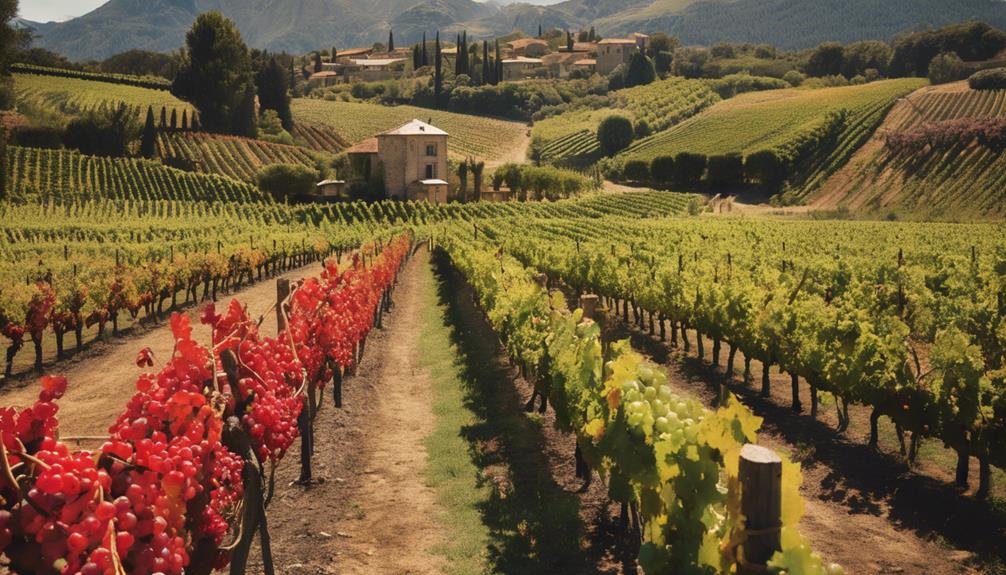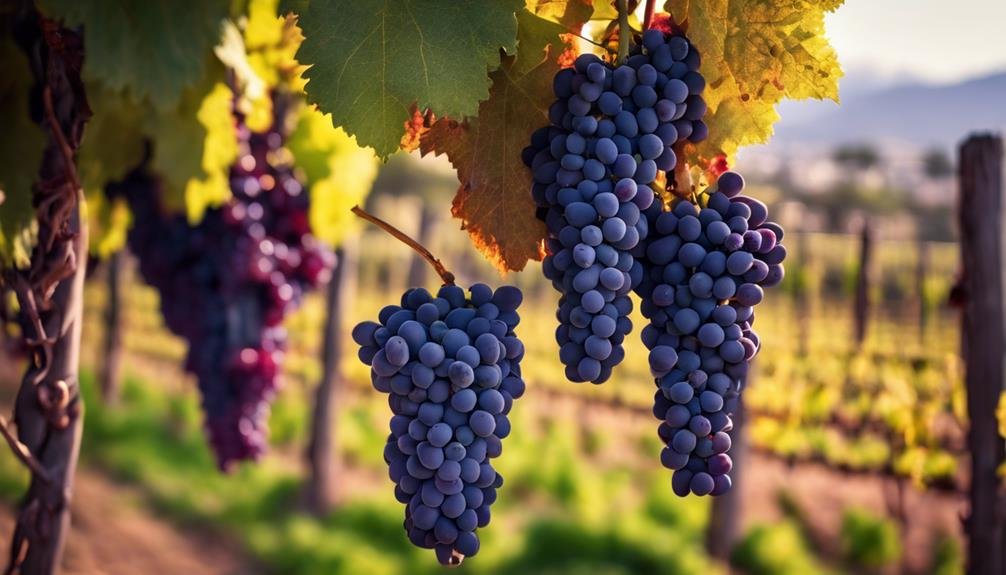In a wine tasting showdown, Chilean Carménère triumphs, impressing with its distinct flavors and deep cultural roots. Chile leads in producing this medium-bodied wine, celebrated for its bell pepper aromas and high pyrazine levels. The 2018 Legado Reserva Carménère stands out with its rich profile of blackberry, tobacco, and green tannins, making it a unique experience. This wine from the Maipo Valley fuses tradition with terroir, showcasing Chile's winemaking expertise. Comparing French and Chilean Carménère reveals similarities in structure and fruitiness, but Chile takes the lead in cultivation. Discover more about this global sensation's origins and flavor nuances.
Chilean Carménère: A Global Sensation
Chilean Carménère has emerged as a global sensation, enchanting wine enthusiasts worldwide with its distinctive flavors and rich cultural heritage. This grape variety, once mistaken for Merlot, has gained immense global popularity due to its unique characteristics.
Chile leads in Carménère production, offering medium-bodied wines with red and black fruit notes. Known for its high pyrazine levels, Carménère exhibits vegetal aromas like bell peppers, setting it apart from other red wines.
The global appeal of Chilean Carménère lies in its ability to deliver a one-of-a-kind tasting experience that reflects the terroir and tradition of the Maipo Valley. As wine lovers continue to explore the world of Carménère, its allure and complexity only add to its international acclaim.
Maipo Valley: Terroir and Tradition
Nestled within the heart of Chile's winemaking region, the Maipo Valley epitomizes a harmonious blend of terroir and tradition.
The terroir influence in Maipo Valley plays an essential role in shaping the unique characteristics of the wines produced in the region. With its warmer climate, Maipo Valley is known for nurturing Bordeaux grape varieties, resulting in wines with distinctive earthy tones.
Winemaking techniques in Maipo Valley are deeply rooted in tradition, reflecting the rich cultural history of winemaking in Chile.
The combination of terroir and traditional winemaking practices in Maipo Valley contributes to the production of wines that showcase the authentic Chilean character, making them stand out in the global wine scene.
French Vs. Chilean Carménère Comparison

The comparison between French and Chilean Carménère wines reveals intriguing similarities in their medium-bodied nature and distinctive red and black fruit notes.
While France currently has limited Carménère plantings compared to Chile, both French and Chilean Carménère are known for their balanced medium-bodied structure.
The flavor profiles of these wines often showcase rich red fruit flavors like cherry and raspberry, complemented by hints of darker fruits such as blackberry and plum.
Additionally, the earthy undertones in French Carménère are akin to the characteristic Chilean terroir influence found in these wines.
This shared essence in their flavor profiles highlights the versatility and unique qualities that Carménère from both regions can offer to wine enthusiasts seeking a delightful sensory experience.
Tasting Notes: 2018 Legado Reserva Carménère
Drawing on the distinctive traits of Carménère wines from diverse regions, the 2018 Legado Reserva Carménère presents a compelling profile with its deep ruby color and aromas of blackberry, dark chocolate, and balsamic.
This wine carries a rich flavor profile characterized by blackberry and tobacco notes, accompanied by a vegetal nature and green tannins that add complexity to each sip.
The suggested food pairings, such as steak with mushrooms or grilled vegetables, complement the wine's bold yet balanced characteristics.
The 2018 Legado Reserva Carménère stands out for its deep, enticing color and a palate that combines fruity and earthy elements, making it a versatile and enjoyable choice for those seeking a unique wine experience.
Carménère: Origins and Flavor Profile

Originating from Bordeaux, France, Carménère is a varietal known for its distinct flavor profile characterized by high pyrazine levels, imparting vegetal aromas such as bell peppers.
The Bordeaux connection of Carménère dates back to its origins in France, where it was once a prominent grape variety until the phylloxera outbreak in the 1870s.
Surprisingly, it was rediscovered in Chile in 1994, where it thrived and gained recognition for its unique characteristics.
Pyrazines, the compounds responsible for the bell pepper notes in Carménère, are found in higher concentrations in this grape compared to others, contributing to its unmistakable flavor profile.
This makes Carménère a standout choice for wine enthusiasts seeking a wine with a distinctive taste profile.
Frequently Asked Questions
What Makes Maipo Valley an Ideal Region for Carménère Cultivation?
Maipo Valley's ideal Carménère cultivation stems from its unique terroir. The region's well-drained soils rich in gravel and sandy loam coupled with a warm climate allow for excellent grape ripening. Vineyard management practices and precise winemaking techniques further enhance Maipo Valley's suitability for Carménère production.
How Did Carménère End up Being Mistaken for Merlot in Chile?
The confusion between Carménère and Merlot in Chile stemmed from historical mislabeling in vineyards. Due to their similar appearance, Carménère vines were often mistaken for Merlot until a French scientist correctly identified the grape in 1994.
Are There Any Unique Cultural Traditions Associated With Carménère in Chile?
In Chile, Carménère is intertwined with cultural celebrations, enhancing the nation's festive spirit. Traditional Chilean festivities often feature Carménère as a focal point, paired expertly with local cuisine, showcasing the wine's versatility and connection to Chilean heritage.
How Does the 2018 Legado Reserva Carménère Differ From Other Chilean Carménères?
Utilizing the idiom 'a cut above the rest,' the 2018 Legado Reserva Carménère distinguishes itself through a distinctive flavor profile marked by blackberry, dark chocolate, and tobacco notes. Remarkable for its green tannins, this wine exhibits promising aging potential.
What Sets French Carménère Apart From Chilean Carménère in Terms of Taste?
In comparing French and Chilean Carménère, the influence of terroir is paramount. French Carménère may exhibit more herbaceous and mineral notes, reflecting its Bordeaux origins, while Chilean versions often showcase riper fruit flavors due to their warmer climate.
Conclusion
To sum up, Chilean Carménère has become a global sensation in the world of wine, showcasing its unique characteristics and flavors.
An interesting statistic to note is that Chile is the leading producer of Carménère grapes worldwide, with the Maipo Valley being a key region for its cultivation.
This article highlights the exceptional quality of Chilean Carménère wines, inviting wine enthusiasts to explore and appreciate the rich history and distinct taste profile of this varietal.